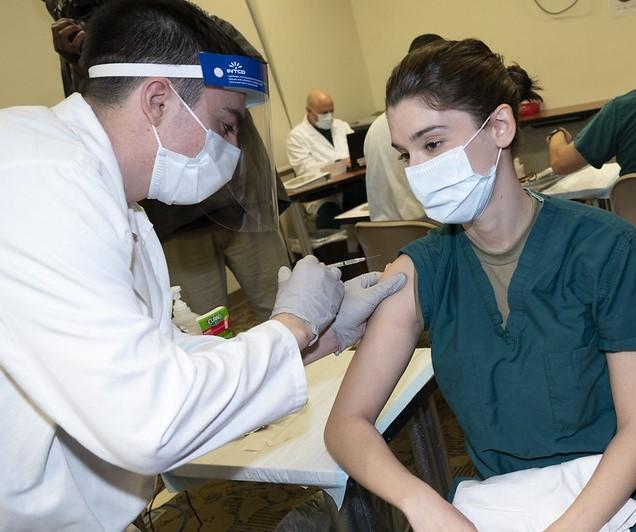Today in separate press conferences the Centers for Disease Control and Prevention (CDC) and members of Operation Warp Speed addressed the two major hurdles facing COVID-19 vaccination campaigns in the United States: slow distribution and safety concerns.
Since the vaccines were approved for emergency use in mid-December, most states have focused on vaccinating the recommended top priority groups: healthcare workers and residents of long-term care facilities. But no states have yet to fully use their current allotment of vaccine.
"We cannot let perfection be the enemy of good," said Department of Health and Human Services Director Alex Azar during an Operation Warp Speed media briefing on vaccine rollout. "Prioritized recommendations are simply recommendations, they should never stand in the way of getting shots in the arms."
Azar said the slow start was partly explained by the timing of vaccines arriving during the winter holidays. But he also said governors needed to be more aggressive in distributing vaccines.
"We need to not be overly prescriptive," he said, explaining that if people in top priority groups had been offered the vaccine and doses were left over, governors should quickly start offering the vaccine to people over the age of 70 or 65, or those at risk for being hospitalized with severe COVID-19.
In other news, Moncef Slaoui, PhD, Operation Warp Speed's chief scientific adviser, confirmed he will remain part of President-elect Joe Biden's transition team and continue to consult on vaccine developments. He also said he expected two new vaccine candidates, one from Johnson & Johnson and one from AstraZeneca, to file for emergency use authorization in the coming weeks.
The Johnson & Johnson candidate, notable because it requires a single dose, is expected to file by the end of the month, and AstraZeneca's vaccine (already being used in the United Kingdom) should file in the first week of March, Slaoui said.
As of yesterday, the CDC's COVID-19 tracker showed 17,020,575 million COVID-19 vaccine doses have been distributed in the US, and 4,836,469 doses have been administered. Operation Warp Speed officials said today they expected 20 million doses each of the Pfizer-BioNTech and Moderna vaccines to be distributed by the end of the month.
Vaccine-related anaphylaxis
Today Nancy Messonnier, MD, the director of the CDC's National Center for Immunization and Respiratory Diseases, said that though the COVID-19 vaccines are considered extremely safe, there is a risk of anaphylaxis—a severe allergic reaction—at a rate of 11.1 per 1 million doses administered based on events during the first 3 weeks of vaccination.
To compare, the seasonal flu vaccine carries with it a risk of 1.3 anaphylactic events per 1 million doses.
"The risk of poor outcomes from COVID is still more than a risk from the vaccine, and fortunately we know how to treat anaphylaxis," Messonnier said.
In today's Morbidity and Mortality Weekly Report, the CDC describes 21 events of anaphylaxis linked to COVID-19 vaccinations. The median age of patients was 40, and the average time from vaccine injection to allergic reaction was 13 minutes. Seventeen of the 21 patients had a known allergy to medicines, food, or insects.
"There was no geographic clustering of cases," said Messonnier, who also said anaphylaxis was seen with both the Pfizer-BioNTech and Moderna vaccines. She also said that anyone who suffers an allergic reaction to the first dose of a COVID-19 vaccine should not get the second dose.
Messonnier also said these events have not changed plans for vaccine distribution. "We want to be sure any administration site for vaccines is prepared with staff that need to know what to do if a patient has anaphylaxis." Nineteen of the 21 patients were administered epinephrine onsite, and though all patients recovered, some required hospitalizations.
Messonnier fielded several questions on vaccine hesitancy, and said she was disappointed to hear that healthcare workers have been refusing the vaccines.
In related news, CVS Health and Walgreens said they expect to complete the first round of vaccinations in nursing homes and assisted living facilities by Jan 25, but reported lower-than-expected uptake in staff.
As of yesterday, just 429,000 doses of the 3.2 million doses allocated through the federal pharmacy partnership for long-term care programs had been administered. A federal partnership with retail pharmacies has been the cornerstone of Operation Warp Speed's plan to widely distribute the vaccine to Americans. According to Politico, the White House now estimates 3,000 to 6,000 pharmacies could begin administering COVID-19 shots by the end of January.
Arizona, California report worsening surges
Both Arizona and California are reporting their third and worse surges of the novel coronavirus, with only 136 of Arizona's 1,800 intensive care unit beds available. In the first week of 2021, the state is averaging more than 8,000 new cases per day, more than double the rate they were seeing last summer.
In California, especially around the Los Angeles metropolitan area, hospitals are quickly reaching capacity, with 8,000 people in Los Angeles County currently hospitalized. Eleven thousand deaths have been reported in Los Angeles County since the start of the pandemic.
Overall the United States is averaging 200,000 new COVID-19 cases each day, bringing the outbreak total to 21,201,638 cases including 359,593 deaths, according to the Johns Hopkins COVID-19 dashboard.






















